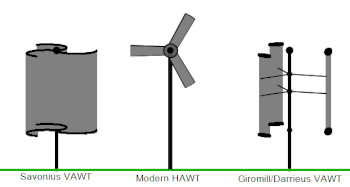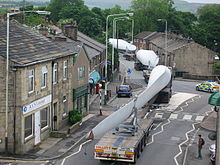 Wind turbines can rotate about either a horizontal or a vertical axis, the former being both older and more common.[13]
Wind turbines can rotate about either a horizontal or a vertical axis, the former being both older and more common.[13]Saturday 10 September 2011
3 Types Wind turbines
Wind turbines can rotate about either a horizontal or a vertical axis, the former being both older and more common.[13]The three primary types:VAWT Savonius, HAWT towered; VAWT Darrieus as they appear in operation.  Wind turbines can rotate about either a horizontal or a vertical axis, the former being both older and more common.[13]
Wind turbines can rotate about either a horizontal or a vertical axis, the former being both older and more common.[13]
 Wind turbines can rotate about either a horizontal or a vertical axis, the former being both older and more common.[13]
Wind turbines can rotate about either a horizontal or a vertical axis, the former being both older and more common.[13]Horizontal axis
Components of a horizontal axis wind turbine (gearbox, rotor shaft and brake assembly) being lifted into position
Since a tower produces turbulence behind it, the turbine is usually positioned upwind of its supporting tower. Turbine blades are made stiff to prevent the blades from being pushed into the tower by high winds. Additionally, the blades are placed a considerable distance in front of the tower and are sometimes tilted forward into the wind a small amount.
Downwind machines have been built, despite the problem of turbulence (mast wake), because they don't need an additional mechanism for keeping them in line with the wind, and because in high winds the blades can be allowed to bend which reduces their swept area and thus their wind resistance. Since cyclical (that is repetitive) turbulence may lead to fatigue failures, most HAWTs are of upwind design.
Modern wind turbines
Turbine blade convoy passing through Edenfield in the UK
Turbine design and construction
 Wind turbines are designed to exploit the wind energy that exists at a location. Aerodynamic modeling is used to determine the optimum tower height, control systems, number of blades and blade shape.
Wind turbines are designed to exploit the wind energy that exists at a location. Aerodynamic modeling is used to determine the optimum tower height, control systems, number of blades and blade shape.Wind turbines convert wind energy to electricity for distribution. Conventional horizontal axis turbines can be divided into three components.
- The rotor component, which is approximately 20% of the wind turbine cost, includes the blades for converting wind energy to low speed rotational energy.
- The generator component, which is approximately 34% of the wind turbine cost, includes the electrical generator, the control electronics, and most likely a gearbox (e.g. planetary gearbox,[25] adjustable-speed drive [26] or continuously variable transmission[27]) component for converting the low speed incoming rotation to high speed rotation suitable for generating electricity.
- The structural support component, which is approximately 15% of the wind turbine cost, includes the tower and rotor yaw mechanism.[28]




